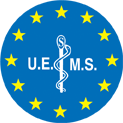Upper GI SURGERY - Logbook requirements
The "transferable competency" of UGI Surgery requires assessed and documented numbers for "Knowledge and Skills". Candidates for the qualification must demonstrate skills in each of the above areas of responsibility and be able to present a complete and signed log-book.
The candidates' individual LOG-books have to fulfill the UEMS criteria. In the LOG-book for each item patient's initials (or hospital admission number), type of procedure, date of procedure and approval with signature by independent expert have to be provided.
The individual LOG-books for the categories A, B and C are scrutinized in the Eligibility I process.
The minimal Eligibility requirement for a UEMS UGI Surg qualification is a proved number of 800 credit points for interventions and / or procedures, endoscopies and operations (categories A + B + C).
For each intervention (A) as principle surgeon /endoscopy (B) as principle surgeon or operation (C) performed by the candidate as assistant 1 credit point is given.
For each operation (C) performed by the candidate as principle surgeon (the principle surgeon is the person who performs the majority of the essential steps of the procedure) 2 credit points are given.
At least 50% of the total number of 800 credit points have to achieved as principle surgeon.
This means, that a total of 400 interventions/procedures/endoscopies/operations (categories A + B + C) are the minimum requirement, when they are all performed as principle surgeon.
Upper GI | Thorax | |
A.Interventions, Procedures | n=100 | n=100 |
B.Endoscopies | n=365 | n=365 |
C.Operations (total) | n=315 | n=315 |
Thorax | n=80 | n=210 |
Abdomen (major resections) | n=210 | n=80 |
Minimal invasive endoscopical procedures | n=25 | n=25 |
For pragmatic reasons provisional arrangements are provided (see below: "Provisional arrangements") to enhance the qualification until complete European harmonization of surgical training is achieved.
These provisional arrangements allow a range of different compensations to consider various national and/or individual situations.
SOP: Provisional arrangements
Category A and B: The 60% rule
The total number of 280 credit points for the Categories A and B resp. is mandatory. Within the Categories A and B at least 60% (e.g. ex. 36 MDT and 190 gastroduodenoscopies) have to be reached.
Category C: The 75% Rule
The total number of 400 credit points (category C) is mandatory. At least 200 points in cat. 1 B, 1 C and 2 A as principle surgeon. Within each of the 3 subcategories stated under C the particular total number has to be reached at least to 75%. Numeric deficits in one or more subcategories have to be compensated by higher numbers in other groups.
Category A: Interventions & Procedures
If the candidate is not able to present a detailed LOG-book on category A or B "Interventions, Procedures and Endoscopy" a formal confirmation signed by 2 independent experts about the candidates experience in this category may be accepted. In this case the minimum number (n=280 credit points) for category A/B has to be supplemented in category C.
Category B: Flexible Endoscopy
If flexible endoscopy is not performed by the UGI in a specific country, category B may be omitted for the individual candidate. In this case the minimum number (n=220 credit points) for category B has to be supplemented in category C
Catalogue of Interventions, Procedures, Endoscopies & Operations
Thorax / Upper GI | |
Category A: Interventions, Procedures (principal surgeon=1) | n=100 |
| n=15 |
| n=15 |
| n=10 |
| n=60 |
Category B: Endoscopy (principal surgeon=1) | n=365 |
| n=315 |
| n=10 |
| n=20 |
| n=20 |
Upper GI | Thorax | |
Category C: Operations (principal surgeon=2, assistant=1) | n=315 | N=315 |
| ||
| N=20 | N=20 |
| N=80 | N=80 |
| N=20 | N=130 |
| ||
| n=130* | N=20* |
| n=20 | N=20 |
| n=10 | N=10 |
| n=10 | N=10 |
| ||
| N=25 | N=25 |
Procedures done during CCST in surgery or Thoracic Surgery may account
The catalogue may be revised anytime according to UEMS decisions.
- Should include 10 reflux operations
Lars Bo Svendsen, DMSci
Chairman, MJC Upper GI Surgery
Toni Lerut, MD, PhD
Co- chairman, MJC Upper GI Surgery (thorax)
Philippe Nafteux,MD,PhD
Chairman of he UEMS Board of Upper GI Surgery
